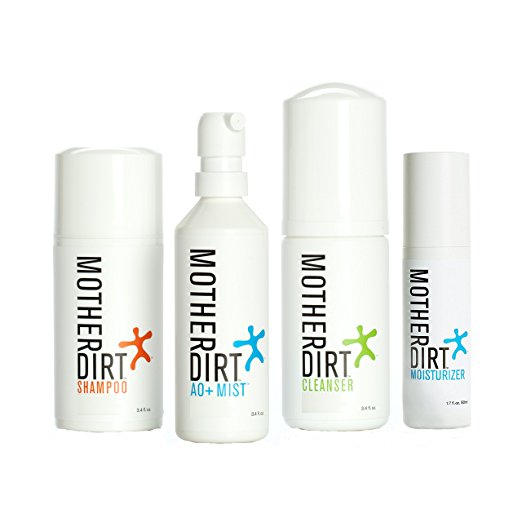
I recently wrote a post about Mother Dirt skincare products. In addition to trying their products, I also had the opportunity to ask Mother Dirt president Jasmina Aganovic some questions about the company’s current and future products, their skincare philosophy, and why spraying bacteria isn’t actually gross at all.
Question: In your opinion, why is this new approach to skincare necessary?
Answer: In just one generation, the amount of products we use daily has grown exponentially. In the process, we’ve interfered with our skin’s own ability to take care of itself. Modern hygiene practices have us using more products than ever before. And yet, despite being cleaner than ever, and having more options than ever, healthy skin seems elusive. The numbers are staggering; 80 million Americans suffer from acne, and 1 in 6 children has eczema. Over 50% of adults claim to have sensitive skin, and it’s the fastest growing category in skin care.
Question: Who do you see as your core customer base?
Answer: We’re really unique in that our customers are 50% men, 50% women. We find that people who embrace the less is more philosophy, and those who steer toward green chemistry and green beauty, as well as those who just like the idea of probiotics for the skin as a wellness concept.
Question: What is your opinion of probiotics in skincare products?
Answer: It’s definitely exciting to see the bacteria/probiotic movement in personal care growing. Although it can be tricky, too. Some products out there marketing themselves as probiotics are most likely not actually living. Unlike food and supplements with probiotics that are typically refrigerated, the need for a multi-year shelf life and the general supply chain requires the use of preservatives in skin care. At the end of the day, this means that the skincare industry does not easily allow for “living” products like the food industry does.
Question: What other skincare applications does this bacteria have besides for the ones your products already treat?
Answer: Our research partner, AOBiome, is currently working with the FDA on clinical trials using different formulations of Ammonia Oxidizing Bacteria (AOB). You’re welcome to check out their site for more information.
Question: Are there are other bacteria besides AOB that can help our skin?
Answer: Most likely, yes. However, the field is young and our area of research remains specifically on AOB.
Question: Only one of your products has AOB in it. Are you creating other products that will contain AOB? And if not – why?
Answer: We never stop formulating and working on new products. Because of the novel and highly constrained nature of biome-friendly formulation, this is going to take a lot of time and work. We hope to one day have more products with AOB as well as others to supplement it.
Question: Your products do not contain organic ingredients, why not?
Answer: Our primary screening for formulations and ingredients is the impact on the skin’s ecosystem. Whether or not something is organic or non-organic, we have found no difference of impact on the skin microbiome.
Question: If a customer uses just the products (shampoo, moisturizer) and not the AO+ spray will they still see positive skin changes or must you use the spray for best results?
Answer: While the Mist is our hero product, there are definitely people who use only the Cleanser, Shampoo, or Moisturizer and have great results and see changes in their skin. Our studies show that there is benefit to be gained by using those products on their own, and even more benefit to be gained by incorporating the Mist as well.
Question: The products have a very short shelf life – will this always be the case or are you working on a way to get around this issue?
Answer: Our products will most likely always have a shelf life because not having preservatives is one of the traits that makes them biome-friendly. (Preservatives are anti-bacterials, and our goal is to keep the bacteria alive.) We are constantly working to do what we do better, and since we’ve launched our products, we’ve improved our shampoo and cleanser formulations to extend their shelf life from 4 weeks from first use, to 8 weeks from first use. It’s likely that packaging innovation will also play a role in extending shelf life.
Question: Can someone undergoing chemotherapy or another cancer treatment safely use your products?
Answer: Anyone who is immunocompromised should consult their physician before changing anything in their routine.
Question: How can someone who lives outside the US purchase the products?
Answer: We sell our products on our website, Amazon, and we ship internationally to a few countries. You can find out which regions we ship to on our site.
Question: What’s next? What new products are in the pipeline?
Answer: We always have a lot of things in the works, but it takes a long time to work through the product development process. There are a few exciting launches coming later this year and we hope to share more soon.
Question: What is the most gratifying experience to come out of creating these products?
Answer: The positive feedback from our users is a really amazing thing to experience on an ongoing basis. We truly feel like we are creating a major shift in the world of public health and we have always approached it as a community-based mission.
Question: What is the message you want to get out to potential customers who might find the concept of spraying bacteria on their faces gross?
Answer: Ha! While some people still have the “ick” factor around spraying bacteria on their skin, the idea makes sense to most people. We have gut bacteria to thank for that! Once people make the connection between how you need good bacteria to keep your gut healthy and balanced, they can understand how the same applies to your skin. Our AOB used to be a naturally occurring bacteria on our skin up until about 100 years ago, but harsh chemicals and less time spent outdoors wiped it away. We’re just helping you put back what was once already there, and still exists everywhere in nature where living things thrive. You come in contact with AOB when you’re digging through rich soil, or swimming in a lake. Of course, there are still hurdles to overcome, but people have certainly been much more receptive than we expected.










 The term chiral is derived from the Greek work for handedness and a molecule is called chiral if it differs from its mirror image. (A simple way to visualize this concept is to think of your right and left hand. You can`t fit your left hand in your right glove, right? That`s because they`re chiral. You can learn more about the idea
The term chiral is derived from the Greek work for handedness and a molecule is called chiral if it differs from its mirror image. (A simple way to visualize this concept is to think of your right and left hand. You can`t fit your left hand in your right glove, right? That`s because they`re chiral. You can learn more about the idea 

Recent Comments